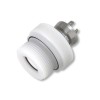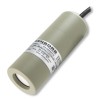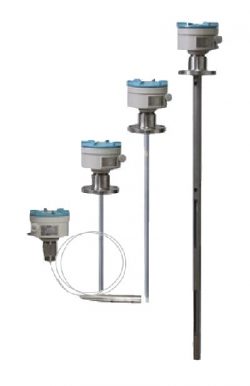 Capacitance sensing probe devices for measuring liquid level and converting it to an electrical signal to send to other instrumentation.
Capacitance sensing probe devices for measuring liquid level and converting it to an electrical signal to send to other instrumentation.
A capacitive liquid level sensor is an instrument for measuring the height of a liquid and converting it to an electrical signal. The liquid level signal output can then be utilised by other instrumentation to display, monitor, log or control the liquid level.
Capacitive liquid level sensors are measurement devices which typically consist of a single probe which acts as an immersed electrode inside a tank. This probe interacts with an opposite electrode, usually the the wall of the tank, and the two are connected together to form a capacitor.
The liquid contents of the tank act as the dielectric medium, which will affect the capacitance created between the two electrodes. If the liquid level rises and falls, this will change the capacitance measured by the probe in a predictable way, and therefore it can be used very effectively as a measurement of liquid level.
The change in capacitance can be measured by applying an alternating voltage and current between the two electrodes, with a frequency typically in the radio frequency (RF) range.
Featured liquid level measurement products
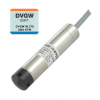 LMP307 Submersible Level Transmitter - Submersible level transmitter for measuring liquid level with a 4-20mA current loop or a 0-10V voltage output plus optional ATEX approval for intrinsically safe use in hazardous areas in ranges from 1mH2O up to 250mH2O. The LMP307 is suitable for use on potable water with no leaching, and can be supplied with a drinking water certificate according to DVGW and KTW.
LMP307 Submersible Level Transmitter - Submersible level transmitter for measuring liquid level with a 4-20mA current loop or a 0-10V voltage output plus optional ATEX approval for intrinsically safe use in hazardous areas in ranges from 1mH2O up to 250mH2O. The LMP307 is suitable for use on potable water with no leaching, and can be supplied with a drinking water certificate according to DVGW and KTW.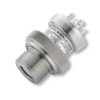 Hydrostatic Level Sensors - Hydrostatic pressure sensing devices for measuring liquid level and converting it to an electrical signal to send to other instrumentation.
Hydrostatic Level Sensors - Hydrostatic pressure sensing devices for measuring liquid level and converting it to an electrical signal to send to other instrumentation.
A capacitive liquid level sensing probe makes direct contact with the liquid to be measured, and therefore material compatibility has to be a consideration, but for most applications a stainless construction is more than adequate for most fluids. Despite the material considerations, capacitance liquid level measurement is very reliable due to there being no moving parts to contribute to the wear and tear of the device.
Since the capacitive probe is essentially a stainless steel rod fitted to a tank, it is possible to construct the device to withstand high pressures so that it can be used on sealed pressurised tanks.
Also since there is no sensitive components immersed in the fluid it is possible to use on higher temperature media that could not be tolerated by other types of liquid level sensor.
Capacitive liquid level sensing probes are generally mounted through the top of a tank with probe protruding vertically into the tank and extending down to the minimum required level.
Featured liquid level measurement products
 Pressurized tank level indicator with dual sensor input and Ethernet - Monitor pressurized tank levels with the CMC-N16 wall-mount indicator. This configuration supports dual pressure sensor inputs, enabling differential pressure-based level measurement with visualization, data logging, and remote monitoring capabilities.
Pressurized tank level indicator with dual sensor input and Ethernet - Monitor pressurized tank levels with the CMC-N16 wall-mount indicator. This configuration supports dual pressure sensor inputs, enabling differential pressure-based level measurement with visualization, data logging, and remote monitoring capabilities.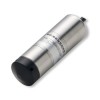 Storm surge protected low range submersible river level transmitter - This submersible level transmitter offers accurate low range water level monitoring with high overpressure resistance for storm surge protection in rivers
Storm surge protected low range submersible river level transmitter - This submersible level transmitter offers accurate low range water level monitoring with high overpressure resistance for storm surge protection in rivers
Advantages
- Works well on dielectric fluids
- Simple mechanical construction
- No moving parts requiring regular inspection and maintenance, or leading to wear and tear
- High temperature fluid compatibility since no sensitive components make contact with the fluid
- Sealed pressurised or evacuated vessels will not affect performance
Disadvantages
- Doesn’t work with conductive fluids without insulated outer tube
- Thick or sticky media will leave a coating on the probe creating an insulation layer causing malfunction, or affect performance
- Requires calibration to distinguish difference between liquid and air.
- Sensitive to changes in media which cause dielectric constant to change
- Probe protruding into liquid causing obstruction, attracting fouling and hygienic cleanliness issues
Featured liquid level measurement products
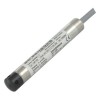 LMP305 Borehole Level Transmitter - Submersible stainless steel pressure transmitter ideal for geotechnical surveying with a 19mm diameter for measuring hydrostatic water level in bore-holes.
LMP305 Borehole Level Transmitter - Submersible stainless steel pressure transmitter ideal for geotechnical surveying with a 19mm diameter for measuring hydrostatic water level in bore-holes.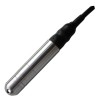 Wash water break tank submersible level transducer with 1.6 m range and 4-20mA output - Monitor wash water levels in break tanks with this submersible 4-20mA transducer. Features high accuracy, 5m vented cable, and robust design.
Wash water break tank submersible level transducer with 1.6 m range and 4-20mA output - Monitor wash water levels in break tanks with this submersible 4-20mA transducer. Features high accuracy, 5m vented cable, and robust design.
Related Help Guides
- Measuring the volume of liquid in a horizontal cylinder tank
- Atmospheric pressure compensation for hydrostatic level sensors
- Determining the signal cable length of a suspended liquid level transducer
- Measuring diesel level in shallow tanks
- Installing a submersible level sensor horizontally
- Selecting the correct pressure sensor range for low-level applications
- Measuring liquid level in a sealed tank with a hydrostatic pressure sensor
- Difference between vented and non-vented water level measurement
- Determining water tank volume using hydrostatic pressure
- How do you measure the volume of a liquid using pressure
- Measuring liquid level in a tank using a dp sensor
- Calculating required pressure range for fuel tank level measurement
- How does changes in Local Gravity affect Hydrostatic Pressure
- Using absolute pressure sensors to measure hydrostatic level
- Determining the hydrostatic pressure range for a tank level sensor
- Using a screw-in or waterproof pressure transmitter to measure liquid level
- How to determine milk tank level and volume from pressure
- Improve the electrical termination of vented submersible pressure sensors
- Considerations for monitoring Landfill Water Level
- Why are Submersible applications so demanding of Pressure Transducers?
- Are all IP68 Water Resistant Protection Ratings the same
- Converting non-vented depth readings & barometric pressure to true depth
- Liquid Level Measurement
Related Technical Terms
- Capacitive Fluid Level Measurement
- cmH2O – Centimetres of Water Column at 4 deg C Pressure Unit
- Conductive Fluid Level Detection
- Float Fluid Level Detection
- ftH2O – Feet of Water Column at 4 deg C Pressure Unit
- mH2O – Metres of Water Gauge at 4 deg C Pressure Unit
- mmH2O – Millimetres of Water Column at 4 deg C Pressure Unit
- Specific Gravity
- Vibrating Tuning Fork Fluid Level Detection
Related Online Tools
- Liquid Level to Hydrostatic Pressure Calculator
- Fluid Depth, Density, Gravity, and Pressure Calculator
- Liquid Level Transmitter 4-20mA Current Output Calculator
- Vertical Cylindrical Shaped Tank Contents Calculator
- Horizontal Cylindrical Shaped Tank Contents Calculator
- Rectangular Shaped Tank Contents Calculator
- Pressure to Liquid Level Calculator
Related Product and Application Help
- Portable battery powered tank level gauge with submersible sensor
- 300 cm water level sensor for submersing in tank
- 200 metres of water column head pressure gauge
- HART flameproof (Ex d) re-scalable level transmitter for hydrostatic head up to 2 metres
- Dockside sea water tide level transmitter up to 6 metres depth
- 40 foot high diesel tank submersible pressure sensor


